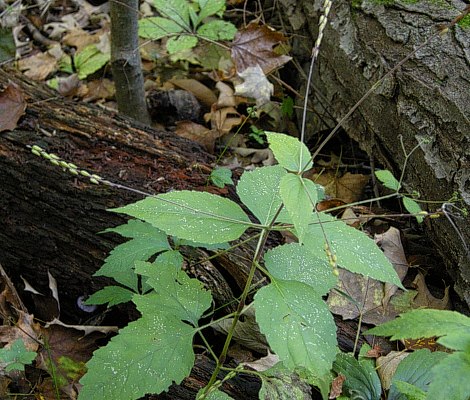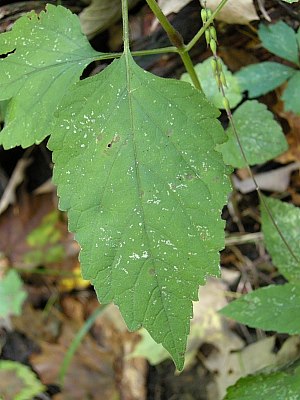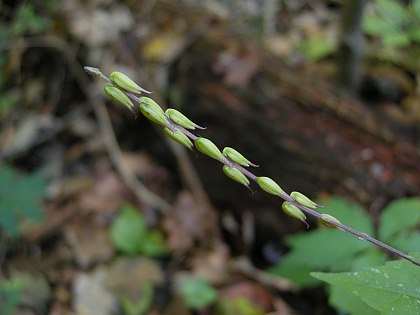Description: This herbaceous perennial plant is about 1½–3' tall. It is more or less erect and either sparingly branched or unbranched. The stems are light green to dark purple, angular-terete, and slightly pubescent. Pairs of opposite leaves occur along each stem. The leaf blades are up to 5" long and 2½" across; they are dull green, hairless, ovate in shape, and crenate-dentate along their margins. The lower leaves have slender petioles up to one-half the length of their blades, while the upper leaves have much shorter petioles.

The upper stems
terminate in slender spike-like racemes of flowers up to 1' long. In
addition, secondary racemes are often produced from the uppermost pairs
of leaves. The flowers are arranged in opposite pairs along the upper
one-half or upper one-third of each raceme. The central stalk of the
raceme is usually dark purple. Each flower is up to 1/3" (8 mm.) in
length; it consists of a tubular-ovoid calyx and a slender corolla that
is pale purplish white and divides into two lips. The small upper lip
has a rounded edge, which is slightly indented in the middle; the long
lower lip divides into 3 lobes, functioning as a landing pad for
visiting insects. Within the corolla, there is a single style and 4
stamens. The small calyx is light green and hairless; it has 3 teeth
that are long, slender, and purple along its upper/outer side, while
the opposite side of the calyx has a pair of much smaller teeth. The
pedicels of the flowers are very short; at the base of each pedicel,
there is a pair of
tiny bracts (bracteoles). While individual flowers are blooming, they
are held horizontally; shortly afterwards, their corollas fall away and
their calyces bend downward to become appressed against the stalk of
their racemes. The blooming period occurs during the summer and lasts
1-2 months. Only a few flowers are in bloom at the same time. Each
flower produces a single seed that develops within the calyx. This
plant reproduces by reseeding itself.
Cultivation:
Lopseed prefers a sheltered location that provides light to medium
shade, moist to mesic conditions, and a rich woodland soil with
abundant organic matter.

Range &
Habitat:
The native Lopseed has been found in most counties of Illinois, however
it is only
occasionally encountered and its populations are scattered (Distribution
Map). Habitats include rich deciduous woodlands in moist to
mesic conditions. Lopseed is largely restricted to higher quality
woodlands where the original ground flora is still intact. While it is
little known, Lopseed has a wide distribution in North America and
east-central Asia.
Faunal Associations:
Small bees occasionally visit the flowers for nectar. Robertson (1928)
observed only two bees, Ceratina dupla and Augochlorella
striata, as floral visitors of Lopseed. The former species is
a Little Carpenter bee, while the latter species is a Green Metallic
bee. Other records of floral-faunal relationships are sparse. A
polyphagous insect, Proxys punctulatus (Black Stink
Bug), sucks juices from the foliage of Lopseed (and many other plants).
White-Tailed Deer reportedly dislike this plant as a food source and
don't graze on the foliage.
Photographic Location:
Spitzler Woods in Macon County, Illinois. The photographs were taken
during the autumn when the flowers were no longer in bloom.

Comments: This woodland plant is often overlooked because it lacks showy flowers. As a general rule, shade-loving woodland plants that bloom during the summer have small light-colored flowers because they have access to very limited amounts of energy from low levels of sunlight. Plants that grow in open woodlands or prairies have access to more sunlight and usually produce larger flowers. Woodland wildflowers that bloom in the spring can also produce large showy flowers, largely because the canopy trees haven't fully developed their leaves, and thus more sunlight reaches the ground vegetation. Lopseed is an unusual plant that has been assigned to its own plant family. It resembles members of the Mint family (Lamiaceae) in many ways, but each of its flowers produces only a single seed. In contrast, individual flowers of plants in the Mint family typically produce either 2 or 4 seeds.